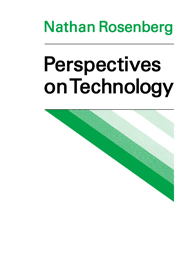Book contents
- Frontmatter
- Contents
- Acknowledgments
- Introduction
- Part 1 Some origins of American technology
- Part 2 The generation of new technologies
- Part 3 Diffusion and adaptation of technology
- Part 4 Natural resources, environment and the growth of knowledge
- 12 Technology and the environment: an economic exploration
- 13 Technological innovation and natural resources: the niggardliness of nature reconsidered
- 14 Innovative responses to materials shortages
- 15 Science, invention, and economic growth
- Epilogue
- Notes
- Index
13 - Technological innovation and natural resources: the niggardliness of nature reconsidered
Published online by Cambridge University Press: 09 January 2010
- Frontmatter
- Contents
- Acknowledgments
- Introduction
- Part 1 Some origins of American technology
- Part 2 The generation of new technologies
- Part 3 Diffusion and adaptation of technology
- Part 4 Natural resources, environment and the growth of knowledge
- 12 Technology and the environment: an economic exploration
- 13 Technological innovation and natural resources: the niggardliness of nature reconsidered
- 14 Innovative responses to materials shortages
- 15 Science, invention, and economic growth
- Epilogue
- Notes
- Index
Summary
Concern over the adequacy of natural resources has always been a central preoccupation of economists. The management of the human enterprise at both the household and larger societal levels has always been perceived to be dependent upon the intelligent management of the limited resources made available by the natural environment. Indeed, this is evident in the very etymology of the word “economy,” which derives from the Greek words oikos (house) and nomos (manage), or the management of household affairs. When economics as a discipline is conceived as dealing with the problems of the household writ large the obvious and central question is how the resource endowment constrains the production of goods and services.
Some of the basic insights of classical economics emerged out of this preoccupation with natural resource constraints. Malthus and Ricardo were both pessimistic about the long-term prospects for economic growth in an economy experiencing substantial population growth and with only a fixed supply of land available for food production. Indeed, as Malthus argued, in an “old” country population growth was always pushing society against the limits imposed by the fixed supply of land and subsistence incomes were, as a consequence, inevitable – at least for the working class. Indeed, it was in speculating about the consequences of Great Britain attempting to grow its own food supply as population continued to grow that classical economics formulated one of its central relationships – the law of diminishing returns. It is worth noting that the formulation of this law clearly distinguished both a quantitative and a qualitative dimension.
- Type
- Chapter
- Information
- Perspectives on Technology , pp. 229 - 248Publisher: Cambridge University PressPrint publication year: 1976



